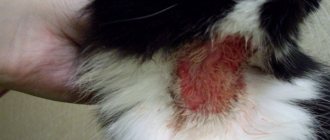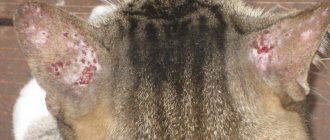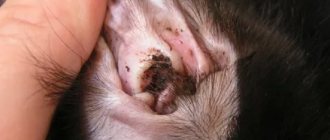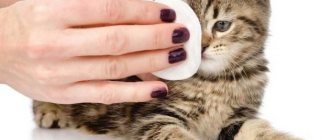What affects tumor formation and symptoms?
Before prescribing treatment, it is necessary to find out the factor that led to the appearance of the tumor. Typically, a tumor under a cat’s eye occurs for the following reasons:
- Mechanical damage. Trauma often leads to the formation of a lump. When a cat hits its head, it develops traumatic swelling. If a pet gets into a fight with another animal, a wound appears under the eye. It can be superficial, deep or through. In this case, the swelling is accompanied by redness of the skin around and the release of blood. Small wounds heal on their own and swelling subsides. For deeper injuries, a bandage is applied and the animal is taken to the veterinarian.
- Foreign body. Small objects can get under the eyelid: dust, dirt, pollen, sand, thorns. The eye is very hot to the touch, and fluid flows out of it. Self-removal of a foreign body is not recommended, as it can damage the mucous membrane, which will lead to complications.
- Lack of vitamins, metabolic disorders. In these situations, inflammation of the eyelids is a typical symptom. Simple inflammation is manifested by swelling and redness of the edges of the eyelids. With inflammation of phlegmosis, the skin under the eyes swells, and abscesses with pus inside form.
- Inflammation of the cornea or conjunctiva. With keratitis, swelling and redness around the eyeball are observed. Conjunctivitis is characterized by increased tearing and accumulation of mucous secretion in the corners of the eyes.
- Inflammatory processes in the eyelid. Blepharitis often causes swelling under a cat's eye. In addition to swelling, there is pain. The skin in the affected area is hot to the touch and tense. The cat constantly lies with his eyes closed, as blinking causes pain.
- Diseases of the cardiovascular or urinary system. Some diseases cause fluid to accumulate in the muzzle area. At the same time, the animal becomes weak and feels unwell.
- Oncology. A malignant neoplasm causes loss of vision and severe swelling. In later stages it cannot be treated.
Detection of suspicious symptoms is a reason to consult a veterinarian, as the pet’s health may be in serious danger.
Lumps behind the ears: causes of appearance
A lump behind the ear is often a common occurrence and, as mentioned above, is not an indicator of anything serious.
Painless bumps behind the ears
- Sebaceous cyst (sebaceous cyst): a hard lump behind the ear, a non-cancerous growth that develops around the sebaceous glands.
- Lipoma: A harmless, fatty growth that can develop in the layer of our skin and can eventually become larger.
- Benign tumor behind the ear: a soft, painless, mobile growth that gradually develops from the tissue of the salivary glands in the ear area. Although these tumors are generally harmless, one particular type, called cholesteatoma, can destroy tissue around it and cause dizziness, fluid buildup in the ear, and even hearing loss.
- Malignant tumor behind the ear: very similar to skin cancer. This (mostly) painless growth develops behind the ears and may require medical attention if it grows in size.
Painful lumps behind the ears
- Abscess: develops when tissue or cells become infected. Our bodies respond to infection by sending white blood cells to the affected area. As a result, pus begins to accumulate, forming a lump.
- Dermatitis: Often associated with fatigue, stress, thrush or neurological conditions, which leads to a build-up of dead skin cells or dry skin. As a result, bumps appear behind the ear, accompanied by inflammation and redness.
- Mastoiditis (inflammation of the mastoid process of the temporal bone): a condition caused by infection of the mastoid process of the temporal bone, which can lead to swelling and lumps behind the ear. Often accompanied by headaches, fever or hearing loss.
- Enlarged lymph nodes: Enlarged lymph nodes are often associated with a common cold, which causes small, soft, painful swellings behind the ears.
- Acne: A condition caused by hormonal changes, stress, or high levels of staph infections on the surface of the skin, including behind the ears.
- Otitis media: The official term for ear infection. May cause swelling behind the ear in the form of a lump.
First aid
It happens that it is not possible to immediately contact a veterinarian. Then it is recommended to take measures to provide first aid to alleviate the pet’s condition:
- ensure peace, eliminate stress factors;
- apply cold to the affected area - this slightly relieves swelling;
- do not touch your eyes unnecessarily, do not rub or massage them;
- Do not treat the animal yourself.
The main principle of first aid is to do no harm. If possible, it is necessary to reduce the pet’s suffering as much as possible and take it to a veterinary clinic.
Treatment
After interviewing the owner, examining the animal and conducting tests, the doctor will prescribe treatment procedures:
- In case of injury - Synthomycin for lubrication, drops (Iris, Tsipromed, Normax, Tobrex), wiping with Furacilin solution. If symptoms worsen, antibiotics are prescribed intramuscularly. Tavegil or Suprastin is given together with injections. The prescription of additional medications is decided by the doctor.
- To remove a foreign body, the cat must be wrapped in a blanket or blanket and carefully, using the edge of a napkin, pick up the speck. It is also recommended to use light eye drops to wash away sand and dust.
- Tumor caused by vitamin deficiency. For simple inflammation, apply ointment under the eyelid (Oxycort, Prednisolone). For phlegmatic inflammation - opening a purulent abscess, intramuscular antibiotics, rinsing with a solution of boric acid or chamomile decoction. Vitamin supplements are a must.
- For keratitis and conjunctivitis - eye drops (Novocain, Levomycetin, Sofradex), corticosteroids (Dexamethasone), ointments (Conjunctivin, Mizofen).
- Blepharitis - disinfection of the edges of the eyelids (brilliant green solution), suspension under the eyelid (oletriin, gentomycin, syntomycin), drops (Sorphadex). The crusts are removed with a cotton pad after wetting with Vaseline ointment.
- Treatment for cardiovascular and urinary pathologies depends on the identified disease. In oncology, the decision about the possibility of treatment is made by the doctor.
A tumor under a cat's eye is an alarming symptom that can lead to health problems for the pet. It is dangerous, so it is recommended to consult a veterinarian for professional help.
What does a swelling under a cat's eye indicate?
It is simply impossible to imagine a home without everyone’s favorite cat, since the pet brings a lot of positive emotions and happiness to its owner. There come times when a cat, like all other animals, gets sick and it is then that the urgent question arises of what to do.
Eye diseases in four-legged animals are quite common, so it is very important to know their possible causes. When a tumor appears under a cat’s eye, you must try to understand why such a disease appeared.
Otitis
A lump near a cat's ear may well be a manifestation of a purulent form of otitis media. Inflammation in the ear is almost never limited to just this symptom. The disease cannot be ignored because it seriously affects the cat’s condition. Animal :
- behaves restlessly;
- constantly scratches the ear;
- loses appetite;
- losing weight.
© shutterstock
Treatment of otitis media that has caused a lump behind the ear depends on its causes. It may require the use of antibiotics, anti-fungal medications, anti-mite drops, and even surgery. Sometimes a tissue biopsy of the lump is recommended to exclude its malignant transformation.
Main causes of tumor
There are many factors that can provoke the appearance of a tumor. Before starting treatment for your pet, it is important to determine what caused such a symptom. Experts identify the following main causes of eye pathologies:
- Injury. A common factor that contributes to the formation of swelling is trauma. If a cat hits its head hard, it may develop traumatic swelling. Fights between a pet and another cat can also become the root cause of eye damage. Wounds of the eyelid can be superficial, deep or through. In this case, the swelling of the eyelid is accompanied by redness of the eyes or slight bleeding. If the wound is shallow, it will heal on its own and the swelling will subside. If there is deep damage to the eyelid, it is necessary to put a bandage on the pet’s eye and take it to the veterinarian.
- Foreign object. A foreign body entering the eye can also cause a tumor. Sand, thorns or some plant can get into the middle. In this case, the eye becomes hot to the touch and exudate oozes from it. Trying to remove the item yourself is not recommended. It's best to take your four-legged friend to the vet.
- Avitaminosis. With vitamin deficiency or metabolic disorders, cats sometimes experience inflammation of the eyelids. For simple inflammation (swelling appears and the edges of the eyelids become red), it is important to use an antibiotic ointment. Oxycort and prednisolone will help your pet recover quickly. Phlegmous inflammation manifests itself in the form of swelling of the eyelid and is accompanied by a purulent abscess. If a cat has such a tumor under the eye, it is recommended to immediately visit a veterinarian and open the abscess. The specialist may prescribe a course of injections, as well as further washing of the eyelid with chamomile or a 3% solution of boric acid.
- Conjunctivitis and keratitis. Inflammation of the eye in the form of conjunctivitis and keratitis is another reason for the formation of a tumor. In the first case, swelling appears around the eye, and redness is also noticed. With conjunctivitis, most often there is increased lacrimation and accumulation of mucous secretions in the corner of the eye. To treat the disease, eye drops are used (0.25% solution of novocaine or chloramphenicol, as well as sofradex or 1% solution of kanamycin).
- Oncology. The previously listed types of eye diseases respond well to treatment. If you quickly determine the cause of the swelling of the eye and undergo a course of procedures, your pet will soon recover. In some cases, a tumor under a cat's eye may indicate the presence of cancer. The pet loses vision and develops swelling under the eyes. Only a veterinarian must treat a malignant tumor.
- Blepharitis. Cats sometimes develop swelling under the eye due to inflammation of the eyelids - blepharitis. In addition to swelling of the eyelids, such a pathology is also accompanied by painful sensations. The eyelids become hot and tense when touched. Blinking provokes painful sensations in your pet, which is why most often he lies with his eyes closed.
- Heart and kidney disease. If a cat's eyelids are swollen, then in some cases this indicates a dangerous disease of the internal organs. In this case, the excretory and cardiovascular systems suffer. The general malaise of the cat should alert its owner. A veterinarian must diagnose and treat the disease.
Tumor behind the ear: when to see a doctor
Home remedies are usually suitable for symptomatic treatment, often for a short period of time. If your symptoms persist and you do not experience any relief, you should definitely seek medical help.
Medical assistance for a lump behind the ear is necessary in the following cases:
- the formation does not go away for more than two weeks, even if it does not cause pain (this may be a sign of a serious infection);
- the formation causes a lot of pain and discomfort;
- you have difficulty turning your head or neck;
- you have difficulty swallowing;
- you feel the tumor is growing or spreading;
- your tumor becomes inflamed, pus begins to leak out, or tissue ruptures appear;
- accompanying symptoms do not improve over time or worsen.
Healing ointment Levomekol: costs a penny, but the healing power is worth a million
Black ointment against skin rashes and infections: detoxifies and removes foreign bodies
Folk ways to deal with bumps on your feet
Also watch an interesting video explaining what a lump behind the ear is and how to treat it:
A lump behind the ear usually does not pose any danger and may disappear with home treatment. However, if such swelling or symptoms persist for too long, it is recommended to seek medical attention. Always monitor your condition, carefully examine the lumps behind your ears and be healthy!
Translation and adaptation: headinsider.net / Source
Tumor under a cat's eye photo
How to help your pet?
A few simple safety measures will save the health, and maybe even the life, of your family pet. It is important to adhere to the following rules after identifying a tumor under a cat’s eye:
- Do not take any therapeutic measures on your own. If swelling under the eye is detected, you must visit a veterinarian and adhere to a further course of treatment;
- Applying a cold compress to the sore eye can relieve your pet's suffering. In this case, the swelling will subside a little, after which it is important to show the cat to a specialist;
- Massaging and rubbing the eye is prohibited! Such measures will only increase the cat’s suffering and cause further development of the pathology;
In the desire to help your beloved cat get rid of painful sensations, it is important not to harm. Carrying out home procedures after consultation with a veterinarian will contribute to a speedy recovery of your four-legged friend.
What to do if your cat has a swollen eye?
If a cat's eyes are swollen, the owner can provide first aid to his pet before going to the veterinarian. To alleviate the suffering of the animal, you need to moisten a cotton swab in strong tea leaves, chamomile decoction, a weak solution of hydrogen peroxide, boric acid, potassium permanganate or a solution of furatsilin. A wet swab is carefully applied several times around the eyelid. If there are crusts, they will become soggy and easy to remove.
The procedure is carried out several times a day to achieve a positive result. For a tumor under the eye of a cat, if it is accompanied by purulent discharge, tetracycline ointment helps. A small amount of the product is carefully placed under the lower eyelid. If none of the methods helps, and there is no improvement, then the animal should be urgently shown to a veterinarian.
Lymphadenitis
Lumps that appear under the ears on both sides are most likely a manifestation of lymphadenitis. However, the lymph node can become inflamed on one side. Among the reasons is some kind of infectious lesion located near the ears. These could be diseases of the nasopharynx, dental problems and the same otitis media.
Lymph nodes sometimes enlarge to the size of a walnut (as in the photo), and they hurt a lot . The appearance of cones is accompanied by an increase in body temperature. Lymphadenitis requires a serious approach. A specialist will help you make a diagnosis and select therapy.
In cases where a lump behind a cat’s ear did not appear after a fight, or it takes a very long time to heal and causes discomfort for the animal, you should definitely contact a veterinarian. We can talk about serious diseases that are life-threatening.
Phlegmon is a purulent inflammation of diffuse tissues. Looks like a bump. Happens:
- Primary. Develops after injuries (both closed and open), as a result of infection of wounds.
- Secondary. It becomes a consequence of other diseases. Among them are such serious ailments as purulent arthritis, osteomyelitis, infection with metastases, etc.
Treatment of phlegmon depends on its type and stage. If the cause of a lump behind a cat’s ear is some kind of disease, then the main fight is directed at it. Having eliminated the disease, you can expect that the lump will go away. Although it is often also treated with various drugs to speed up the healing process and alleviate the animal’s condition.
During the first three stages of phlegmon development, the cat is given intravenous antibiotics and novocaine. They use alcohol compresses, Levomekol, and hydrogen peroxide as means for external use.
To prevent your cat from licking the medicine, it is recommended to place a special collar around its neck. In more serious situations, medications may be needed to support the heart and nervous systems.
Possible causes of eye tumor in a cat
A tumor under a cat's eye can occur for several reasons. Cats are inquisitive and difficult to keep track of. An infection could have entered the animal's body; the tumor could have been caused by poor care or low immunity. The cause of the tumor can also be inflammation of the eyelids, the tissues around the eyes are hot and tense. Swelling around the eyelids may indicate problems with the excretory or cardiovascular system.
A post shared by Morekotov (@more.kotov) on Apr 10, 2020 at 2:27am PDT
The cause may be a head hit on a hard object if the animal is active, runs and jumps a lot. The root cause of the damage may also be a fight with another cat. When injured, swelling appears under the eye. The animal behaves restlessly and the eye may become watery. This reason is difficult to determine, because there is no bruise after the injury. If the injury occurs in the presence of the owner, then a cold compress can be applied to the bruised area.
If a bruise occurs, a wound may appear; if it is not deep, it will heal on its own. In case of deep wounds and bleeding, it is necessary to urgently apply a bandage to the diseased organ of vision and show the pet to a doctor.
Foreign body
A foreign body, a midge, a speck or sand, could get into the eye. In addition to the tumor, purulent discharge or tears may appear. It is not recommended to pull out a foreign body on your own; it is better to contact a specialist at a veterinary clinic.
Conjunctivitis
The cause may be conjunctivitis, how to help, the eye is swollen and causes pain to the pet even with a slight touch. In addition to swelling, redness of the mucous membrane and tearing are observed. With this disease, purulent yellowish mucus is released. After sleep, the eyelids stick together, the animal hides from the light.
In this case, you should urgently contact a veterinarian to alleviate the pet’s suffering. The disease is caused by an infection that can also be transmitted to humans. The animal should be protected from communication with children; it should not be allowed into sleeping areas or personal hygiene items.
Tumor
Swelling in the eye area may indicate the presence of a neoplasm. At the same time, the cat is poorly oriented in space, because his vision decreases. The tumor will be hard to the touch, and the animal's temperature will rise. Only an examination at a veterinary clinic will allow you to make an accurate diagnosis and prescribe the necessary treatment.
Causes of bumps on a cat's body
Bumps on a cat's skin can appear for a variety of reasons. In most cases, they are quite harmless and can be easily eliminated if necessary. In some cases, without timely consultation with a doctor and proper treatment, the animal may die.
Incorrect injection
Sometimes, after an injection, a small lump under the skin may be detected in a cat. Often it does not cause the animal any discomfort. If no infection gets under the skin during the injection, the lump will resolve after a few days. If the seal is hot and inflamed, and the cat is uncomfortable touching it, it is better to show the animal to a doctor. Perhaps the animal had an allergic reaction to the medicine, or an infection got into the wound.
Lipoma
This neoplasm is often called a wen. It looks like a small dense ball that can be rolled under the skin. It may appear in one place or throughout the body. In some cases, it can rapidly increase in size.
This is a benign disease that does not metastasize. However, at any moment it can develop into oncology (for example, if an animal scratches this area).
Lipomas appear due to:
- lack of movement;
- hormonal imbalances;
- disruption of the endocrine system.
In most cases, a lipoma does not cause any concern to the cat. Sometimes it can be located near nerve endings. In this case, the cat may feel pain when pressed. If the tumor is on the paw, the animal may limp.
Sometimes a lipoma forms in the area of the carotid artery, this can lead to the death of the animal. Lipomas formed in the spine area are also dangerous. They can lead to compression of nerve endings and paralysis.
Hematoma
Formed as a result of mechanical trauma. Bleeding occurs under the skin. The hematoma can reach quite large sizes. Swelling, redness and inflammation appear on the skin, and swelling is possible. If the animal did not have any associated injuries, the hematoma itself will soon decrease in size and disappear completely. In some cases, the hematoma can transform into a cyst.
You might be interested in: What causes diarrhea in a cat?
Abscess
It can even appear from a small wound if it gets infected. Pus begins to accumulate under the skin and swelling forms. It can cause the animal quite a lot of discomfort. Body temperature rises significantly, and hair in the affected area may fall out.
Over time, the abscess may open on its own, after which pus will begin to come out of the wound. If the wound is completely clean, the inflammation may soon go away completely. It is also possible that pus will begin to accumulate in this area again. In the worst case, blood poisoning can occur. That is why it is better to show the animal to a veterinarian immediately.
An abscess can occur due to:
- insect bite;
- incorrectly given injection;
- contamination of wounds or scratches.
Insect and parasite bites
Insect bites can lead to infection of the wound and the formation of abscesses. They can cause an allergic reaction, which can result in severe inflammation of the skin.
The tick can penetrate deep into the skin, causing the cat to develop slight swelling. You should contact your veterinarian to have the parasite removed. Under no circumstances should you tear it off, otherwise parts of the tick’s body may remain in the skin and begin to fester.
It is worth remembering that ticks carry life-threatening infections for cats. Therefore, it is better to avoid any contact with them altogether. The animal should be periodically treated with special products that will protect against tick bites.
Lymphadenitis
Two symmetrical bumps form under the cat's jaw. They are quite painful. The animal feels unwell, so its activity drops significantly; loss of appetite. Due to a bacterial or viral infection entering the body, severe inflammation of the lymph nodes occurs. Lymphadenitis often appears against the background of serious diseases, which may well lead to the death of the animal.
Mastitis and mastopathy
Inflammation of the mammary glands often occurs in unsterilized cats. Swelling forms in the nipple area. The lump can reach large sizes. Often, when touching the inflamed area, the cat feels severe pain, its body temperature may increase, and the animal’s activity decreases significantly. During feeding, blood and pus may be present in the milk.
These diseases can appear in young cats that have never given birth as a result of hormonal imbalances. They can also be associated with stagnation of milk if the cat has lost her kittens.
Eosinophilic granuloma
A small dense red spot appears on the skin. Most often it forms on the cat's upper lip or belly. In the first stages, there are no other symptoms of the disease. Over time, the spot enlarges and turns into an open wound.
On the face, it affects the cheek, neck and chin. Bacteria can enter the wound, which often leads to inflammation, the formation of abscesses and pathological changes in the internal organs.
Cyst
A cyst is a formation whose cavity is filled with serous or purulent fluid. It can appear on any part of the animal's body. Often the pathology does not cause much discomfort. Develops as a result of blockage of the sebaceous glands, or disruption of lymph circulation.
The cyst can have different sizes. Due to injury or other reasons, it may rupture, causing fluid to leak out.
Some parasites (alveococcus, echinococcus) can lead to the formation of cysts. They are also dangerous for humans. In this case, the cat needs to be shown to a veterinarian. The cyst must be removed.
Inflammation of the paraanal glands
Swelling and redness appear in the anal area. Small red bumps form. The animal holds its tail high, rolls its butt along the floor, or often licks the anus. Activity decreases and appetite disappears. Constipation may occur due to inflammation. There is a disruption of the gastrointestinal tract.
You might be interested in: Why does a cat often go to the toilet in a small way: dangerous consequences
Hernia
It may appear as a result of injury, improperly performed surgery, or be congenital. Internal organs prolapse into the abdominal cavity, causing swelling to appear on the skin. It can be of different sizes. It is often soft to the touch. If you press lightly, you can return the organ to its place, but soon it will fall back into the abdominal cavity.
At first, the animal may not experience much discomfort. Over time, your cat may develop a fever. She will feel pain when touching the tumor. In the worst case scenario, the hernia may be strangulated, which will lead to tissue necrosis and intoxication. In this case, the animal may die.
Oncology
The lump can appear anywhere. Often it gradually increases in size. In addition, your cat may exhibit the following symptoms:
- decline in activity, apathy;
- weight loss;
- poor appetite.
Oncology is a deadly disease. Without timely and correct assistance from a doctor, the animal will die. This is why it is so important to diagnose it in the early stages. Even if a small growth on the animal’s skin does not cause any particular concern, the cat should be taken to a doctor and checked. Delay can cost the animal its life.
Treatment of eye tumors
When examining the animal, the doctor determines whether the cornea and eyelid are swollen, whether there is discharge and what type it is, whether there is pain or redness. The sooner treatment is started, the faster the recovery will occur; every lost day increases the risk of complications.
In each case, the veterinarian will tell you what to do to make the cat feel good again. If a foreign body is detected in the eye, the doctor will remove it with sterile tweezers and treat the organ with Furacilin solution.
Treatment for a tumor caused by injury will depend on the severity of the disease. At the veterinary clinic, the eyes are washed and, if necessary, a 2% Novocaine solution and antimicrobial drops are instilled. In case of severe complications, even surgical intervention is possible. For a speedy recovery, it is recommended to feed your cat with vitamin A.
For conjunctivitis, regular eye rinsing, drops and ointments are prescribed. For infectious diseases, if necessary, the doctor prescribes antibiotics and immune drugs. This will avoid complications and more severe diseases. Medicines are used only for their intended purpose and according to the instructions that come with them.
If a dense tumor is found in the eye area and the animal has a high temperature, an urgent biopsy is required. The test results will show whether the tumor is benign or malignant. If necessary, surgery to remove the tumor is prescribed.
Phlegmon
Phlegmon is a diffuse purulent inflammation of tissues. Looks like a bump. Happens :
- Primary . Develops after injuries (both closed and open), as a result of infection of wounds.
- Secondary . It becomes a consequence of other diseases. Among them are such serious ailments as purulent arthritis, osteomyelitis, infection with metastases, etc.
Treatment of phlegmon depends on its type and stage. If the cause of a lump behind a cat’s ear is some kind of disease, then the main fight is directed at it. Having eliminated the disease, you can expect that the lump will go away. Although it is often also treated with various drugs to speed up the healing process and alleviate the animal’s condition.
During the first three stages of phlegmon development, the cat is given intravenous antibiotics and novocaine. They use alcohol compresses, Levomekol, and hydrogen peroxide as means for external use.
To prevent your cat from licking the medicine, it is recommended to place a special collar around its neck. In more serious situations, medications may be needed to support the heart and nervous systems.
Prevention of eye diseases
To avoid eye diseases in a pet, the owner must prevent them. It is necessary to monitor the cat’s health, its behavior, nutrition and the state of the gastrointestinal tract. It is important to keep the entire house clean, including your cat's dishes and litter box. Dust and dirt can easily get into your pet's eyes and cause illness.
Your pet should be given a balanced diet to improve the immune system.
It is necessary to care for your pet, comb its fur and examine it regularly in order to identify the disease at an early stage.
To strengthen the immune system and protect against infectious diseases, cats need to be vaccinated in a timely manner. It is recommended to vaccinate from childhood so that adult cats can tolerate diseases more easily.
It is not recommended to self-medicate to prevent complications. Eyes are one of the most sensitive organs; with timely treatment of diseases, vision loss can be avoided.
Prevention of ophthalmic diseases in cats
Before getting a pet, think about the responsibility that falls on you. After all, the health of a pet depends on how strong its body is at an early age, what conditions it is in, what kind of nutrition it has and how well it is cared for.
To avoid unpleasant diseases and ensure a trouble-free existence for your animal, you must do the following for preventive purposes:
- Vaccinations. Timely vaccination will strengthen your kitten’s immunity, after which infectious diseases will no longer be so scary for an adult cat.
- Nutrition. When a cat’s diet is balanced, not only does its immune system improve, but also its appearance, playful mood, and digestion.
- Care. Daily brushing and examination of the cat will prevent any disease, because the disease does not begin suddenly, but with some preliminary incubation period.
If the cat owner does not have sufficient qualifications, then you should not self-medicate. After all, the diagnosis may turn out to be incorrect, and improper treatment can only worsen the disease. It is better to contact a veterinarian once again, since the vision of your pet is at stake, which should bring joy and comfort to your home, and not anxiety and regret.
List and description of possible options
This may surprise many, but even an ordinary houseplant can cause a cat's eye to become swollen and cause severe tearing. But, most often, the reason lies in allergic and bacterial lesions, which are characterized by swelling and other unpleasant symptoms. Below we present to your attention a list of possible reasons by degree of popularity:
- Allergy. The reaction can be triggered by anything from a piece of biscuit to hand washing soap. If we consider by prevalence, food allergies, of course, occupy a leading position in the list of all potential allergens. Often the brand of food or the individual component that is included in its composition is not suitable for animals. This may cause your cat's eye, cheek, or nose to swell. Severe itching and redness will appear. Sores form at the site of scratching. Very often, dermatitis is complicated by a bacterial infection, and scratching wounds contribute to this. Also, swelling in the eye area can be caused by a reaction to house dust, the hair of other animals, or plant pollen. In some cases, an acute reaction may occur when the muzzle is literally swollen before the eyes. This usually happens after contact with household chemicals, harmful gases or poisons. In such cases, the pet requires immediate hospitalization, as there is a risk of death. When it comes to diagnosing and treating different types of allergies, there are a number of difficulties. Namely, determining the allergen in rare cases is possible even with all modern technologies. Therefore, in most cases, they begin by switching to hypoallergenic food and excluding potentially dangerous foods from the diet. Limit the cat's contact with house plants (the juice of some species is very toxic), detergents, powders and other potentially dangerous substances of chemical origin. Owners of decorative breeds should always have antihistamines (tavegil, fenistil, suprastin) in their first aid kit, since their pets are at risk for allergic reactions.
- Insect bites. You should be aware that even after being bitten on the nose, your cat's eyes may become swollen. This applies to stinging insect bites (wasps, bees). Rarely, swelling may appear after fly or gadfly bites. Even less common from ants. Typically, the site of a wasp sting swells within minutes. There is also redness in this area. If the moment of the bite comes into the owner’s field of vision, then it is possible to avoid serious consequences if you give the pet an antihistamine (a quarter of suprastin) in time. But, most often, owners state the fact that their animal bit something. In such cases, it is necessary to carefully examine the bite site, as a sting may remain there, which must be removed. In decorative breeds (Maine Coon, Siamese, bobtail), the allergic reaction after cuttings is much more severe. Symptoms may persist for up to several days. Hospitalization is required in cases where, due to swelling, there is a risk of blocking the airways (swelling of the throat or nose). Immediate hospitalization is also indicated for angioedema and anaphylactic shock.
- Oral problems. They are found mainly in cats over the age of 10 years. Breeds with a flattened muzzle are at risk because they have congenital bite problems. A cat's eye may become swollen on one side due to a fistula or abscess. They, in turn, can be caused by deep caries, tartar, cysts or granulomas. Even if a foreign body gets into the gum, there is a high probability that the cheek will swell, and the eyes may become swollen with it. Problems with teeth can cause serious consequences that affect the health of the animal, so it is recommended to promptly remove stone from the enamel (usually fangs), treat caries and remove roots from broken teeth. It is more difficult with cysts on the roots, since they cannot be identified without an x-ray; in appearance, the tooth may be absolutely healthy. They can also cause the entire face to swell.
- Injury. If a cat's eye is swollen after a fight, then there is a risk of developing a hematoma. It may go away on its own within 2-3 days (you can apply levomekol to the site of swelling) or it will have to be opened and cleaned. And it is better to do it in sterile conditions using antiseptics. After cleaning, drainage is applied to the wound.
Other diseases Is it necessary to somehow treat cones and hematomas of cats?
The cat's body is as fragile as the human body, so the phenomenon of bumps and hematomas on the animal's body also occurs. Not all owners know how to deal with this problem. Some say that our pets “lick” their injuries on their own, while others insist on the need for an immediate visit to an experienced veterinarian. In fact, this issue requires a more detailed discussion, so let's get down to this topic.
Cones - what causes them
You may notice a lump on your pet's body, and most often this is attributed to some kind of injury, especially when your pet has free access to the street. But are you sure that this bump is a swollen bruise? It is quite possible that the problem lies a little deeper than it seems. If the swollen area of skin does not change in any way within a week, then you should make a visit to the veterinarian, since cancerous tumors are as common in pets as in people. You should take this especially seriously and carefully if the swelling was found in an unusual place: the eye, ear, tips of the paws, tail, and so on. As a rule, these places are treated with ordinary bruises at the site of the injury, and the occurrence of swelling there is extremely rare. For prevention, it is necessary to constantly examine your pet’s body. This is done very simply: • Place the pet in a position that is comfortable for him, and examine the surface of the body. Do not forget to remove the fur and easily feel the areas that have a visibly swollen appearance or an unusual skin color. • After this, place the cat on its back to examine the abdominal area. Palpation is carried out in exactly the same way. • The final stage is to examine the ears, head, eyes and tail. Here you need to be more careful.
Bruises and abrasions
Bruises and abrasions are quite common for our furry friends, since cats are very active animals, and they can get so busy that they don’t even notice the injury. This applies not only to street animals, but also to domestic ones. For example, domestic cats can easily hit the corner of the bed, fall from a height, or awkwardly slip on laminate or parquet flooring, skidding into a wall. If you realize that your cat has hurt himself, there is no need to panic, since all this swelling and hematoma in cats goes away on their own. In the course of everyday life, animals experience almost no pain from them. Particularly caring owners will immediately want to anoint the pet’s injured area with some ointment, but this is not necessary. There is no need to press on the painful part of the body again. It is also not recommended to massage this area too much, so as not to cause additional discomfort to the cat. Just wait a while and the disease will go away on its own.
Preventing injuries - is it possible?
We all remember from childhood what bruises, contusions, abrasions and bumps are. Our parents constantly told us to be more careful so as not to injure ourselves more, but did it really work? I still had to smear my knees with brilliant green and also apply plantain. The same applies to cats, animals that are particularly energetic and playful. Your pet will not be able to sit in one place all its life, so do not limit its will, play and walk outside. This way life becomes much more interesting and eventful, and possible bruises and bumps will go away on their own. To reduce the risk of injury, it is enough to create a special place for games at home. When walking with an animal (if the cat is used to the street), do not let it out of the harness, and also do not let it play with stray cats and other animals. Toys should not be too hard or heavy. Also make sure that there are no heavy things in your home that are placed untidy on shelves or other high places.
Swollen eyes in a cat photo
It should be remembered that if a cat's eye is swollen and itchy, then there is a high probability of developing an allergic reaction. If pus is present, the process could be complicated by a bacterial infection. If any of these symptoms occur, it is best to take your pet to the vet, as cytology may be needed to make a correct diagnosis.
Papillomas
Lumps behind a cat's ear can be ordinary papillomas. They are formed if the corresponding virus is present in the body - against the background of weakened immunity, severe stress, etc.
If a tumor is on the ear of a kitten or a very young animal, it is recommended to remove it, and then monitor the animal’s health - increase its defenses, feed it well, and protect it from nervous strain. They try not to perform surgery on older cats.
During the diagnosis, blood is taken from the pet and the type of papillomavirus is determined. If it is aggressive, threatening malignant degeneration, a biopsy is performed.
© shutterstock











